ISSN ONLINE(2278-8875) PRINT (2320-3765)
ISSN ONLINE(2278-8875) PRINT (2320-3765)
Sheetal Shinkhede
|
| Related article at Pubmed, Scholar Google |
Visit for more related articles at International Journal of Advanced Research in Electrical, Electronics and Instrumentation Engineering
This paper reviews the importance of a flexible ac distribution system device for microgrid applications. The device aims to improve the power quality and reliability of the overall power distribution system that the microgrid is connected to. Extended Kalman filters are also studied for frequency tracking and to extract the harmonic spectra of the grid voltage and the load currents in the microgrid. Also this paper high lights on DG grouping in order to harmonize the investment of assets, the quality of power supply and the cooperation with the existing power grid.
Keywords |
| Extended Kalman filter, microgrid, Harmonized grouping, power quality, Security enhancement |
I.INTRODUCTION |
| For traditional power distribution system, the concept of microgrid has offered consumers a reliability and reduction in total energy losses and it has become a promising alternative.[1],[2] While connecting microgrid to the distribution grid, the impact of power quality (PQ) problem on the overall power system performance has to be considered. These PQ problem includes voltage and frequency deviation in the grid voltage and harmonics in the voltage and load currents. To mitigate these problem various equipments such as active filters[3],[4], uninterrupted power supplies[5],[6], dynamic voltage restorers,[7],[8] and UPQC [9] are usually installed by the consumers to protect their loads and system against PQ disturbances in distribution network. But these devices are installed at the consumer sides and the PQ problems that they are capable to handle are usually limited. In this paper a flexible ac distribution system devices are of series and shunt voltage source inverters (VSIs) for the microgrid. The device is installed at the point of common coupling (PCC) of the distribution grid that the microgrid and other electrical loads are connected to. Also, during islanded operation of the microgrid, the device can provide real and reactive power to the microgrid. The device will accomplish the following tasks simultaneously: |
| 1) Compensating for harmonics in the grid voltage and load currents; |
| 2) Real and reactive power control for load sharing during peak periods and power factor correction at the grid side; |
| 3 )Maintaining PQ despite slight voltage and frequency variations in the grid voltage; and |
| 4) Momentarily dispatching real and reactive power to the microgrid when it becomes islanded. |
II. SYSTEM DESCRIPTION |
| The configuration of the microgrid considered in this paper for implementation of the flexible ac distribution system device is shown in Fig. 1. microgrid consists of three radial feeders (1, 2 and 3) where feeders 1 and 3 are each connected to a distributed generation (DG) unit consisting of a microgenerator, a three-phase VSI, and a three-phase LC filter. Feeder 2, however, is connected to an electrical load. The flexible ac distribution system device is operated in two modes: 1) PQ compensation and 2) emergency operation. During grid-connected operation, the microgrid is connected to the distribution grid at the PCC. In this mode, the two DG units are controlled to provide local power and voltage support for loads 1–3 and hence reduce the burden of generation and delivery of power directly from the utility grid. The flexible ac distribution system device functions to compensate for any harmonics in the currents drawn by the nonlinear loads in the microgrid so that the harmonics will not propagate to the rest of the electrical loads that are connected to the PCC. The device also functions to compensate for harmonics in the grid voltage that are caused by other nonlinear loads that are connected at the PCC. The energization of large loads and rapid changes in the load demand may also result in voltage and frequency variations in the grid voltage. Therefore, the device is also equipped with the capability to handle such voltage and frequency variations. |
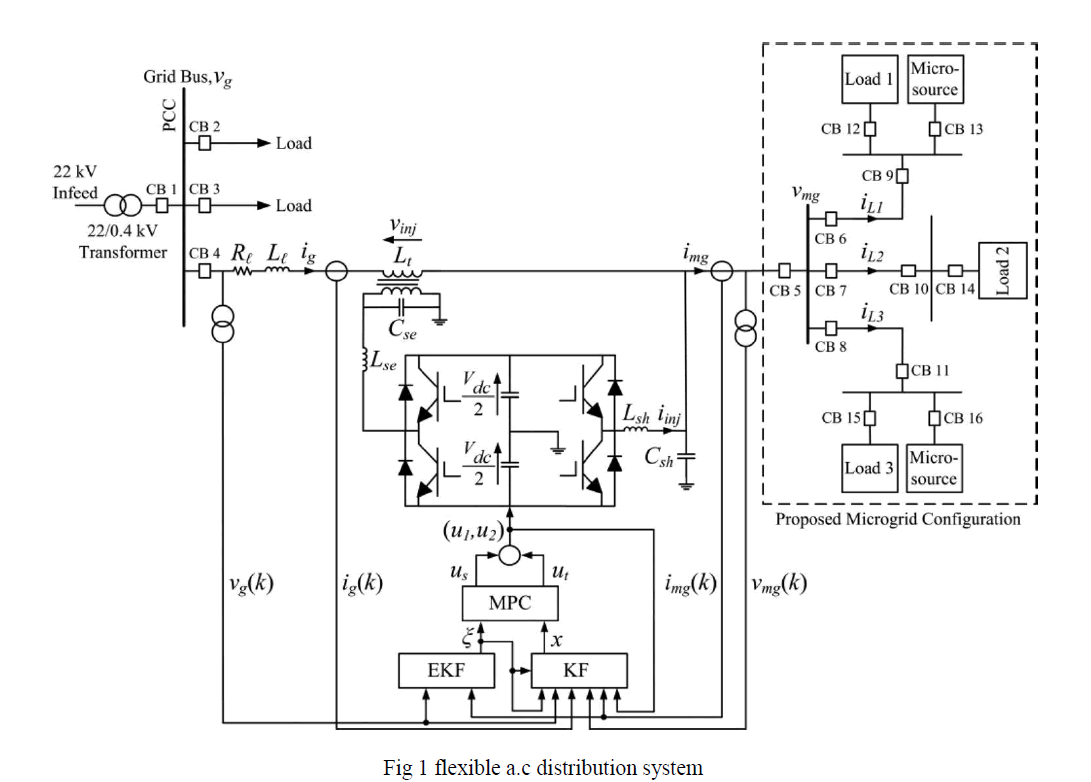 |
| When a fault occurs on the upstream network of the grid, the CBs operate to disconnect the microgrid from the rid. The DG units are now the sole power sources left to regulate the loads. In the case when the generation capacity of the micro generators is unable to meet the total load demand, the flexible ac distribution system device transits to operate in the emergency mode and functions to momentarily provide for the shortage in real and reactive power. |
III. FLEXIBLE AC DISTRIBUTION SYSTEM DEVICE MODEL |
| The single-phase representation of the flexible ac distribution system device is shown in Fig. 3 [10]. The distribution grid voltage at the PCC and the total current drawn by the microgrid are modeled as vg and img, respectively. With the proliferation of power electronics equipment being connected to the distribution grid and the microgrid, both vg and img could be distorted due to the presence of harmonic components. Therefore, Vg is modelled as a source consisting of its fundamental vf and harmonic vh |
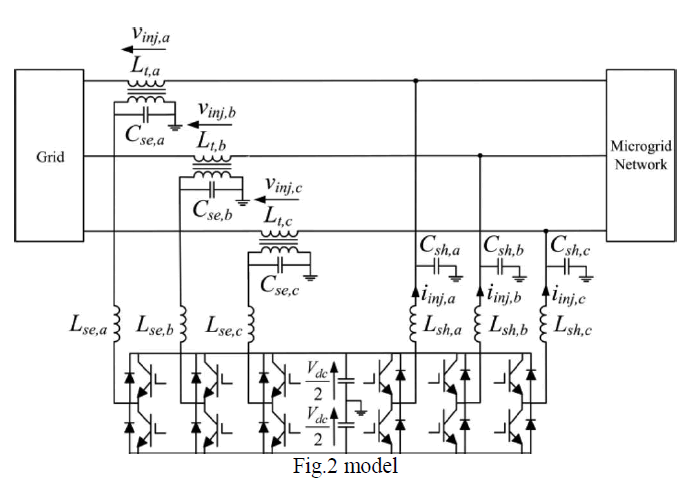 |
| In Fig. 2. the detailed configuration of the three phase flexible ac distribution system device is shown. |
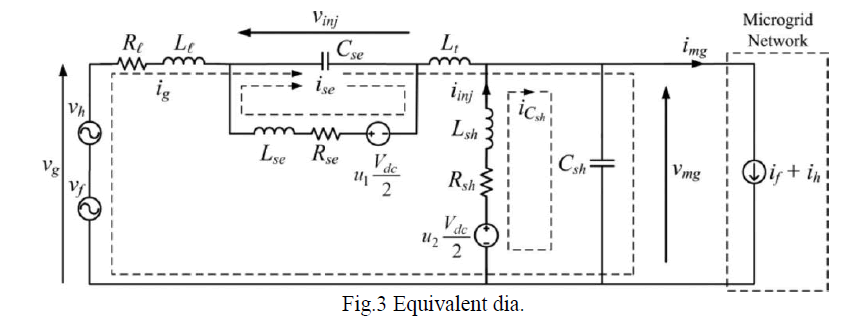 |
| that can be represented by |
| where vf is the fundamental component of Vg with its peak amplitude Vf and vh is a combination of the harmonic components of Vg with its peak amplitude Vh and phase angle θh . To compensate for the harmonics in Vg , the series VSI injects a voltage Vinj that is given by Vinj |
| vinj = vh − vz – vt (2) |
| Similarly, img is also modelled as two components consisting of fundamental if and harmonic ih with their peak amplitudes If and Ih, respectively and is represented by |
 |
| where ÃÂÃâ¢f and ÃÂÃâ¢h are the respective phase angles of the fundamental and harmonic components of img, and if,p and if,q are the instantaneous fundamental phase and quadrature components of img. To achieve unity power factor at the grid side, compensate for the harmonics in the microgrid current and achieve load sharing concurrently, the shunt VSI injects a current iinj that is given by |
| iinj = (if,p − ig) + if,q + ih + iCsh |
| where ig is the grid current. The switched voltage across the series and shunt VSIs of the flexible ac distribution system device are represented by u1 (Vdc/2) and u2 (Vdc/2) , respectively. To eliminate the high switching frequency components generated by the series and shunt VSIs, two second-order low-pass interfacing filters which are represented by Lse, Cse, Lsh , and Csh are incorporated. The losses of the series and shunt VSIs are modeled as Rse and Rsh , respectively. |
IV HYBRID SOURCE FOR DC-LINK VOLTAGE |
| The proposed source for the dc-link voltage of the flexible ac distribution system device consists of a PV array and a battery as shown in Fig. 5. The PV array and the battery are connected to the VSI of the device through a boost converter and a buck–boost converter, respectively, to facilitate charging and discharging operations for the battery and to regulate the dc-link voltage at the desired level. To maintain the dc-link at the reference voltage V*dc/2, a dual loop control scheme in [14], which consists of an outer voltage loop and an inner current loop for the bidirectional converter, is implemented to compensate for the variation in the output voltage Vdc/2 of the dc/dc boost converter. In this section, the operation of the PV/battery system is briefly explained. When there is ample sunlight, the PV array is controlled by the dc/dc boost converter to operate in the MPPT mode to deliver its maximum dc power Ppv at Vdc/2, which induces a voltage error (V ∗dc/2 − Vdc/2) at the dc-link. The error is passed to a PI controller, which produces a reference battery current i∗ b for the inner current loop to operate the battery in either the charging mode for a positive error or discharging mode for a negative error. When the battery is in the charging mode, the bidirectional converter operates as a buck converter by turning switch Q3a OFF and applying the control signal from the controller to switch Q2a ON as shown in Fig. 6. Conversely, when the battery is in the discharging mode, the bidirectional converter operates as a boost converter by turning switch Q2a OFF and applying the control signal from the controller to switch Q3a ON as shown in Fig. 7. Figs. 6 and 7 illustrate the charging and discharging operations of Battery 1, so as to maintain the upper dc-link voltage at a desired value. The same charging and discharging operations are applied to Battery 2 such that the dc-link voltages for both the upper and lower dc-link capacitors are maintained at V ∗dc/2. When the PV array is subject to prolonged period of sunless hours and the state-of-charge of the battery falls below a preset limit, a selfcharging technique from the grid can be incorporated |
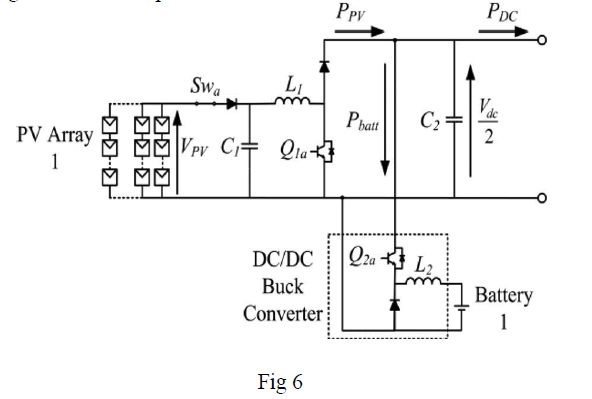 |
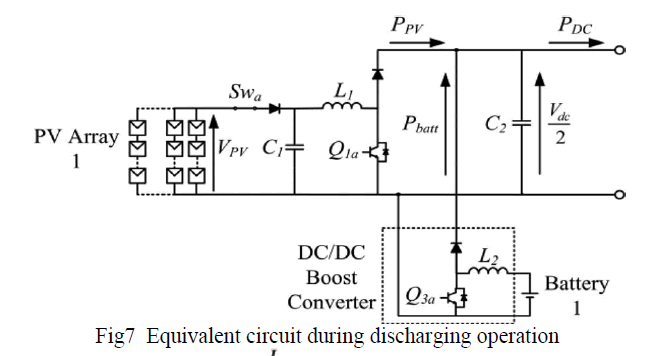 |
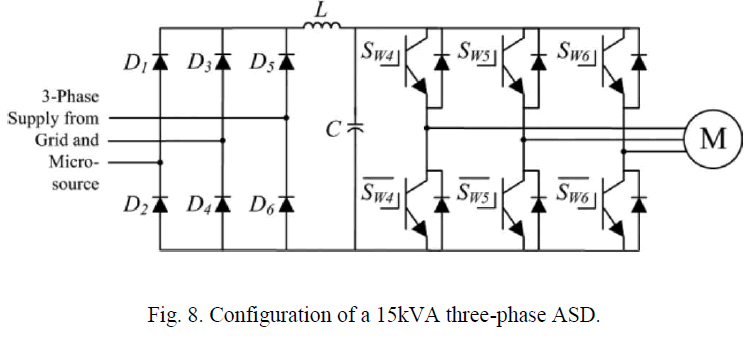 |
V HARMONIZED GROUPING OF NATURAL RESOURCE DG AND SECURITY ENHANCEMENT |
| Output of the natural resource DG, such as the wind plant and the PV plant, is considerably fluctuated with the weather condition. The kW-balance of the total DG output and the demand has to be continuously maintained even in lots of uncertain factors. The battery can be used for absorbing the mismatch energy of the supply-demand balancing in the DG group. From the economical viewpoint, the harmonized grouping can be realized by minimizing the asset investment of the natural resource DG plants and the battery subject to the engineering constraints. The O&M cost, the quality of supply power, the environmental impact and other factors would be included for evaluating the performance of DG grouping. In the model analysis of the harmonized DG grouping, we assume that the kW-balance in the DG group is realized on the average value basis. Total kW-fluctuation of the natural resource plant has to be regulated by the adjustable power of the battery and the spinning reserve from the utility in order to maintain the specified quality of power supply. |
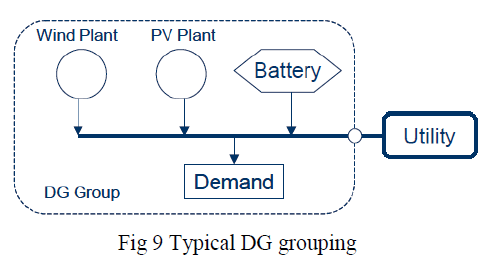 |
VI. CONCLUSION |
| In this paper, a flexible ac distribution system device for microgrid applications has been presented. In this paper, the solution integrates EKF into the control design for frequency tracking and to extract the harmonic spectra of the grid voltage and the load currents. The device is installed at the PCC that the microgrid and other electrical networks are connected to and is designed to tackle a wide range of PQ issues. It also operates as a DG unit to perform load sharing when the cost of generation from the grid is high such that peak shaving is achieved and also during islanded operation of the microgrid. The conclusion is device can handle a wide range of PQ issues, thus increasing the overall PQ and reliability of the microgrid. However, the proposed design concept still needs further validation by experimental studies because measurement errors due to inaccuracies of the voltage and current sensors, and modeling errors due to variations in system parameters could affect the performance of the device in practical implementation. The security enhancement of multiple distributed generation (DG) by the harmonized grouping. |
References |
|